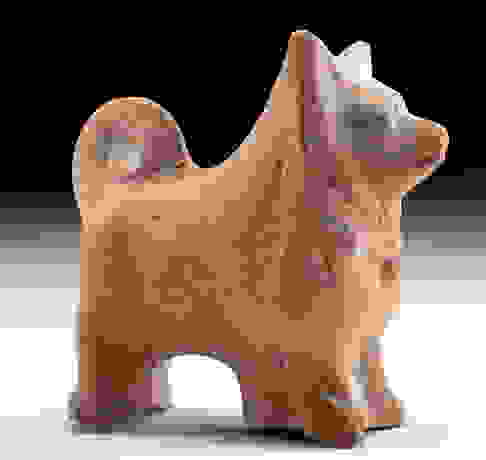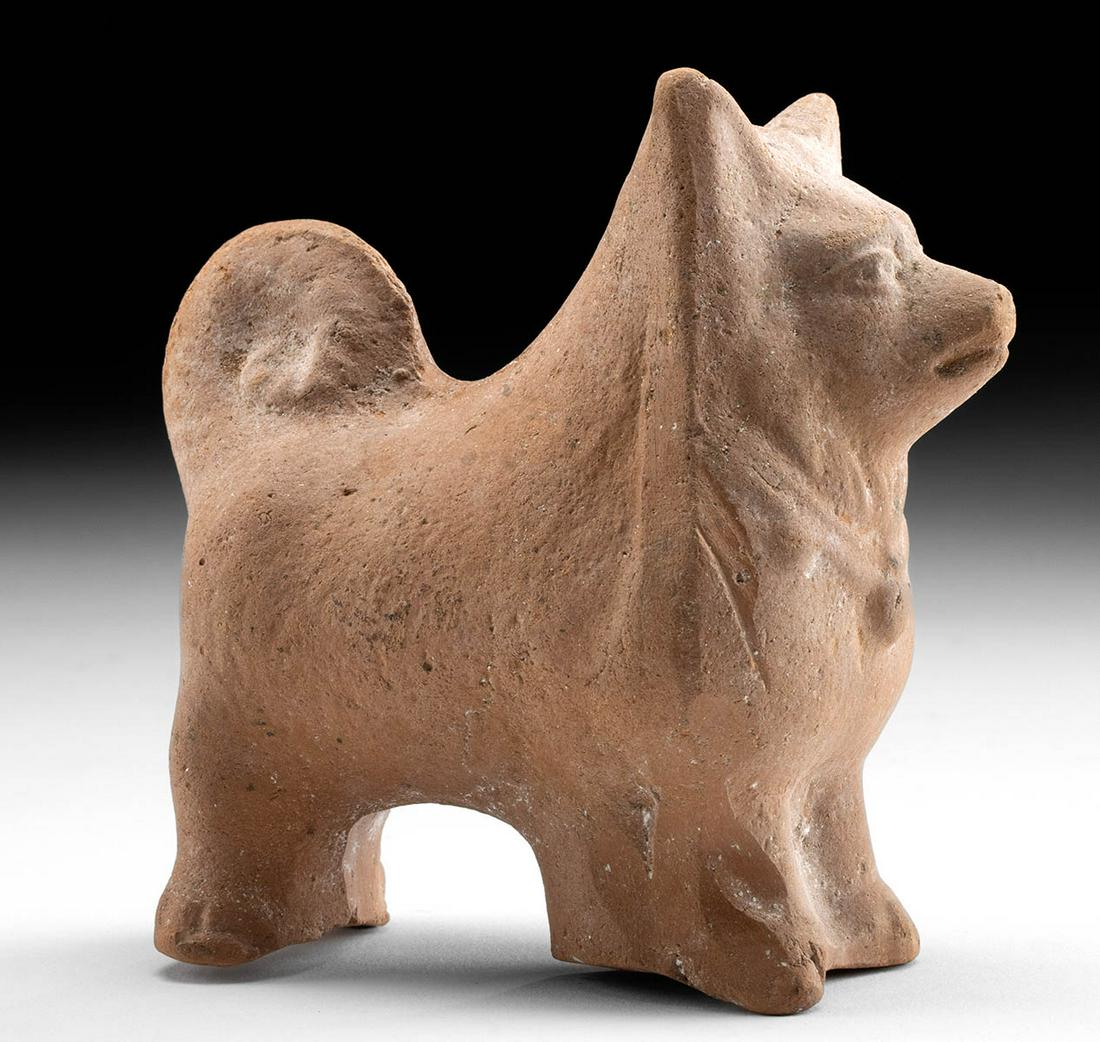
Exhibited / Rare Egyptian Effigy of Sothic Dog, ex MIA
Similar Sale History
Recommended Items







Item Details
Description
Egypt, late Ptolemaic to Romano-Egyptian Period, ca. 1st century BCE to 3rd century CE. An exceedingly rare, mold-formed terracotta canine, known as the Sothic Dog, exhibiting a charming form and rich, layered symbolism. The alert dog stands atop all fours with a raised head, its eyes gazing upwards with woeful brows between a pair of upturned ears and a conical snout, and with a thick tail curled along the rump. The "Sothic Dog" name is derived from the goddess Sopdet ("Sothis" in Greek) and her associated with the star Sirius. The rising of Sirius in the summer sky signaled the inundation of the Nile River and thus the beginning of the Egyptian New Year, which was celebrated with a festival called "The Coming of Sopdet". Sopdet's husband Sahu, representing the constellation Orion, is perhaps represented by the 3 pendants lining the dog's collar. This is especially convincing since Canis Major, the constellation in which the star Sirius resides, is one of the great hunter Orion's 2 large hunting dogs. Size: 4.1" L x 2.125" W x 4.1" H (10.4 cm x 5.4 cm x 10.4 cm)
Egyptologist Dorothea Arnold writes, "Egyptians were closely attached to their dogs, which served as hunting and watchdogs, status symbols, and companions. About seventy dog names are known from texts and inscriptions. They bear striking resemblance to the names given [to] modern pets - from Ebony, Blacky, and Trusty to Son-of-the-Moon, North-wind, Good-for-Nothing, and, more simply, The Fifth or The Sixth." Later, "Many dog burials have been found in Egypt, some with stele bearing the animal's name or with a sarcophagus, and at least one Eighteenth Dynasty leather dog collar has survived." (Arnold, Dorothea. "An Egyptian Bestiary." The Metropolitan Museum of Art Bulletin, Spring 1995, Vol. LII, p. 57)
The goddess Sopdet, known since the Early Dynastic Period as "the bringer of the new year and the Nile Flood", was regarded as one of the most important Egyptian deities given her association with water, the Nile River, the start of the New Year known as Wep Renpet (Wp Rnpt, "The Opening of the Year"), and the renewal of the agricultural cycle as a whole. The rising of Sirius in the early summer skies (known as the "dog star" in late June to early July) also heralded the beginning of the busy trading season as the elevated water levels in the Nile River enabled larger volumes of merchant vessels and trade ships to traverse its vast commercial network; this was celebrated with a festival of "The Coming of Sopdet". This annual renewal of Sirius in the night sky is known as the "Sothic rising" and has been used extensively by modern Egyptologists to accurately construct and revise the historical chronology of ancient Egypt. Sopdet was later called Sothis in Greco-Egyptian times, in association with the star Sirius, but was also known as Sopdet-Anubis due to depictions of the goddess as either a large dog or as a woman riding on the back of a large dog. The symbolism only deepens when including Sopdet's husband Sahu ("the hidden one"), who represented the constellation Orion, since the ancient Egyptian's name for the center star in Orion's belt was called "Sah". The 3 ornaments dangling from the dog's collar perhaps represent the 3 stars comprising the "belt" in the Orion constellation, the center of which being the largest and representing Sahu, which lends credence to associating the goddess Sopdet with this canine effigy.
Exhibited at the Minneapolis Institute of Art with the Lily Place Collection, 1925 to 1958, ref. no. 25.234; at the Los Angeles County Museum of Art (LACMA) from 1986 to 1991; and in the Robert and Frances Fullerton Museum of Art (RAFFMA), California State University, San Bernardino from 1996 to 2023, reference number EL01.175.1996.
Published in Dr. Gerry D. Scott III. "Temple, Tomb and Dwelling: Egyptian Antiquities from the Harer Family Trust Collection." University of California Press, 1992, fig. 75a, pp. 119, 121.
Cf. Wilfong, T.G. "Death Dogs: The Jackal Gods of Ancient Egypt." Kelsey Museum Publication 11, Ann Arbor, 2015, p. 17, fig. 16, object 37; also Cf. a limestone example at The British Museum, museum number EA57356.
Provenance: Collection of Dr. W. Benson Harer, Los Angeles, California, USA, purchased between 1974 and 1975 at Superior Galleries, Los Angeles, California, USA; Exhibited at the Minneapolis Institute of Art with the Lily Place Collection, 1925 to 1958, ref. no. 25.234; at the Los Angeles County Museum of Art (LACMA) from 1986 to 1991; and in the Robert and Frances Fullerton Museum of Art (RAFFMA), California State University, San Bernardino from 1996 to 2023, reference number EL01.175.1996; Published in "Temple, Tomb, and Dwelling", fig. 75a
All items legal to buy/sell under U.S. Statute covering cultural patrimony Code 2600, CHAPTER 14, and are guaranteed to be as described or your money back.
A Certificate of Authenticity will accompany all winning bids.
We ship worldwide to most countries and handle all shipping in-house for your convenience.
#178983
Egyptologist Dorothea Arnold writes, "Egyptians were closely attached to their dogs, which served as hunting and watchdogs, status symbols, and companions. About seventy dog names are known from texts and inscriptions. They bear striking resemblance to the names given [to] modern pets - from Ebony, Blacky, and Trusty to Son-of-the-Moon, North-wind, Good-for-Nothing, and, more simply, The Fifth or The Sixth." Later, "Many dog burials have been found in Egypt, some with stele bearing the animal's name or with a sarcophagus, and at least one Eighteenth Dynasty leather dog collar has survived." (Arnold, Dorothea. "An Egyptian Bestiary." The Metropolitan Museum of Art Bulletin, Spring 1995, Vol. LII, p. 57)
The goddess Sopdet, known since the Early Dynastic Period as "the bringer of the new year and the Nile Flood", was regarded as one of the most important Egyptian deities given her association with water, the Nile River, the start of the New Year known as Wep Renpet (Wp Rnpt, "The Opening of the Year"), and the renewal of the agricultural cycle as a whole. The rising of Sirius in the early summer skies (known as the "dog star" in late June to early July) also heralded the beginning of the busy trading season as the elevated water levels in the Nile River enabled larger volumes of merchant vessels and trade ships to traverse its vast commercial network; this was celebrated with a festival of "The Coming of Sopdet". This annual renewal of Sirius in the night sky is known as the "Sothic rising" and has been used extensively by modern Egyptologists to accurately construct and revise the historical chronology of ancient Egypt. Sopdet was later called Sothis in Greco-Egyptian times, in association with the star Sirius, but was also known as Sopdet-Anubis due to depictions of the goddess as either a large dog or as a woman riding on the back of a large dog. The symbolism only deepens when including Sopdet's husband Sahu ("the hidden one"), who represented the constellation Orion, since the ancient Egyptian's name for the center star in Orion's belt was called "Sah". The 3 ornaments dangling from the dog's collar perhaps represent the 3 stars comprising the "belt" in the Orion constellation, the center of which being the largest and representing Sahu, which lends credence to associating the goddess Sopdet with this canine effigy.
Exhibited at the Minneapolis Institute of Art with the Lily Place Collection, 1925 to 1958, ref. no. 25.234; at the Los Angeles County Museum of Art (LACMA) from 1986 to 1991; and in the Robert and Frances Fullerton Museum of Art (RAFFMA), California State University, San Bernardino from 1996 to 2023, reference number EL01.175.1996.
Published in Dr. Gerry D. Scott III. "Temple, Tomb and Dwelling: Egyptian Antiquities from the Harer Family Trust Collection." University of California Press, 1992, fig. 75a, pp. 119, 121.
Cf. Wilfong, T.G. "Death Dogs: The Jackal Gods of Ancient Egypt." Kelsey Museum Publication 11, Ann Arbor, 2015, p. 17, fig. 16, object 37; also Cf. a limestone example at The British Museum, museum number EA57356.
Provenance: Collection of Dr. W. Benson Harer, Los Angeles, California, USA, purchased between 1974 and 1975 at Superior Galleries, Los Angeles, California, USA; Exhibited at the Minneapolis Institute of Art with the Lily Place Collection, 1925 to 1958, ref. no. 25.234; at the Los Angeles County Museum of Art (LACMA) from 1986 to 1991; and in the Robert and Frances Fullerton Museum of Art (RAFFMA), California State University, San Bernardino from 1996 to 2023, reference number EL01.175.1996; Published in "Temple, Tomb, and Dwelling", fig. 75a
All items legal to buy/sell under U.S. Statute covering cultural patrimony Code 2600, CHAPTER 14, and are guaranteed to be as described or your money back.
A Certificate of Authenticity will accompany all winning bids.
We ship worldwide to most countries and handle all shipping in-house for your convenience.
#178983
Condition
Small nicks and light abrasions, with minor softening to some finer details, and wear to plaster, otherwise intact and excellent. Wonderful preservation to canine form and facial details. Red inventory numbers from MIA written behind front-left foot, and old label reading "75A" on bottom.
Buyer's Premium
- 26.5%
Exhibited / Rare Egyptian Effigy of Sothic Dog, ex MIA
Estimate $5,500 - $8,250
7 bidders are watching this item.
Shipping & Pickup Options
Item located in Louisville, CO, usShip with LiveAuctioneers
Arrange Your Own Shipping
Payment
Accepts seamless payments through LiveAuctioneers

Related Searches
TOP





















































